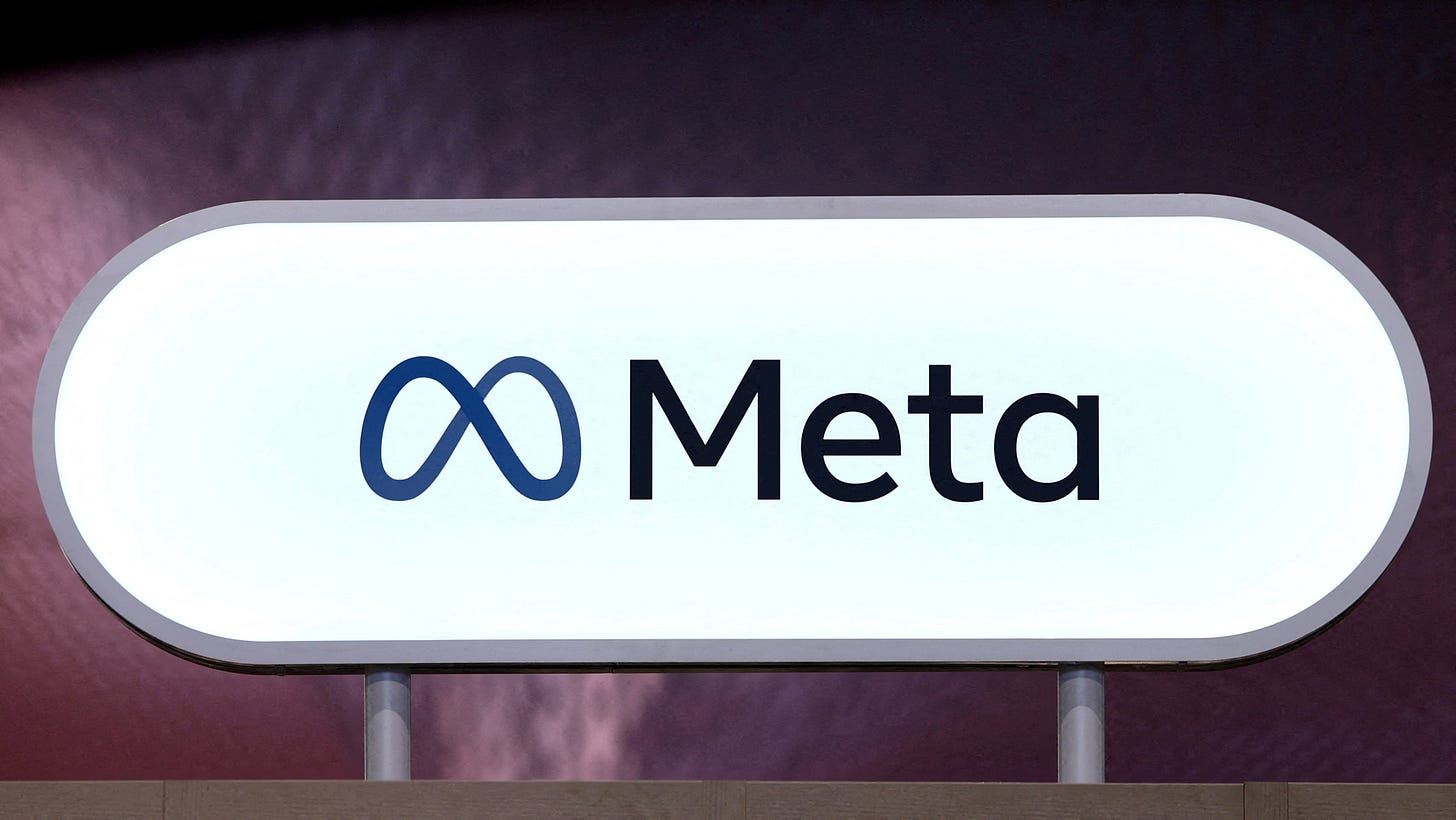
AI: Meta's mega-AI financing deals show roadmap for peers. RTZ #891
I’ve long discussed Meta founder/CEO Mark Zuckerberg’s enormous enthusiasm for AI opportunities in this AI Tech Wave to date. Especially, his enormous appetite to build multi-gigawatt AI Data Center infrastructure that’ll means investments for his company of hundreds of billions in the near future. It’s an AI enthusiasm that’s as real as OpenAI founder/CEO Sam Altman’s , with different dimensions.
And of course Mark Zuckerberg’s energetic acceleration of the AI Talent Wars to now rival and surpass any major sports league on the planet.
That was visible on Meta’s earnings call results this week where Zuckerberg’s statements of ‘aggressive’ AI capital expenditure growth in 2026 sent the stock down 9% at one point despite strong results for the quarter reported. This was in contrast to Google who also reported strong results, with AI capex guidance within market expectations. Same with Microsoft’s results, although market reaction was more muted.
The WSJ reminds us of how the market looks at Meta differently vs Google, Microsoft and Amazon who all have robust Cloud businesses with growing AI revenues that justify accelerating AI capex spending in the tens of billions per company. As they explain in “Meta Still Has a Lot to Prove in AI Race”:
“Facebook parent’s business model sparks more questions about eventual payoff than rivals such as Google, Microsoft.”
“Meta’s problem is that its spending is growing at an even more-rapid pace. Total capital expenditures more than doubled from the same period last year to hit $19.4 billion, and the company took the occasion to signal even greater outlays ahead. It now expects total capex to hit as much as $72 billion this year while projecting significant growth in capital spending and operating expenses for 2026. Meta’s share price fell more than 7% in after-hours trading Wednesday.”
“Microsoft and Google/Alphabet used their own quarterly reports Wednesday to likewise project a jump in AI investments in the coming year. But those companies run large cloud-computing operations that already draw significant business powering AI workloads.”
“That makes the return on their large investments a bit easier to understand—at least relative to a social network that still generates the bulk of its revenue from advertising. Several analysts quizzed Meta’s executives during its earnings call Wednesday about how the stepped-up investments will actually pay off. In a report following the call, Nat Schindler of Scotiabank said the company “will need to see a bevy of new revenue streams to validate their capex ramp.”
And investors are now digesting how Meta’s AI ramp differs vs its peers, despite Mark Zuckerberg being ‘All In’ on AI:
“But the lack of such revenue streams might not force Meta to tap the spending brakes anytime soon. Mark Zuckerberg, co-founder and chief executive, said Wednesday that the company’s aggressive investment strategy is part of a plan to get ahead of the emergence of more-powerful forms of AI he describes as “superintelligence.”
Despite the uncertainty of timing on AI revenues and profits, Meta of course has deep reservoirs of ad revenues off its properties serving 3.5 billion users daily around the world.
“No one knows when that will be, so Zuckerberg says Meta’s investment can still benefit the core business, “which continues to be able to profitably use much more compute than we’ve been able to throw at it.” He added that the company’s AI-powered recommendation systems boosted time spent on Facebook by 5% in the third quarter.”
“Meta isn’t exactly running low on funds. Advertising over a massive social-media platform serving more than 3.5 billion daily users is a particularly lucrative business; Meta is one of only five companies in the S&P 500 to generate more than $100 billion in cash annually from its operations, according to data from S&P Global Market Intelligence.”
But the relative levels are now distinctly noticeable:
“Still, its investments are reaching an eye-popping level. Capital spending of $72 billion this year will equate to 37% of the company’s projected revenue. That is the highest relative spend among its megacap tech peers, and doesn’t even account for the nine-figure offers Zuckerberg has been splashing on top AI researchers. Meta said Wednesday that total expenses will grow at a “significantly faster percentage rate” next year relative to the 23% jump expected this year.”
For now investors have been OK to let Meta ride AI herd with its peers:
“Investors have been treating Meta as an AI winner thanks to its heavy investments as well as Zuckerberg’s aggressive cutting of costs elsewhere. The stock has surged nearly 500% since ChatGPT launched three years ago, vastly outperforming bigger tech rivals save for Nvidia.”
“But the latest results—and the reaction in after-hours trading Wednesday—show the blank check investors have written to the Facebook parent might have an expiration date after all.”
All this explains why Meta is now leaning on external financial mechanisms to fund its ongoing AI investments. And that’s something important to unpack and understand.
On the way to AI Superintelligence, Meta, like most of the Mag 7/MANGO companies, and many tech companies like Oracle and beyond, is ‘bending’ its traditional high margin business model driven by advertising and software, by embracing massive ‘circular’ AI Infrastructure deals off their ever-gushing balance sheets and cash flow. Blending both types of high and low margin business models for now.
But in 2025 we’re on the edge of that boundary for cash generating companies like Meta, Google, Microsoft, and many traditional tech companies. And they are all going to need to resort to debt and equity structures beyond their own balance sheets.
Even as their AI spending is showing up in the broader US GDP numbers.
Again, Meta is in a bit of a lead here. And it’s worth unpacking how they’re entering this new phase going forward.
The Information outlines it well in “The Creative Dealmaking Behind Meta’s $30 Billion Data Center Financing”:
“The company satisfied regulators, accountants and investors in its quest to raise billions but keep its financials unscathed.”
“Meta secured $30 billion for its Hyperion AI data center.”
“Special purpose vehicle keeps $30 billion debt off Meta’s balance sheet.”
“Complex financing structure gained approval from SEC and rating agencies.”
The details follow:
“It took a year and some financial acrobatics, but Meta Platforms and a small army of bankers and lawyers were able to secure funding for a $27 billion data center project without doing any immediate damage to the company’s finances. A private letter from the Securities and Exchange Commission helped seal the deal.”
“How Meta and Morgan Stanley pulled off the fundraising, and whether other companies racing for dominance in artificial intelligence will be able to match their feat, will potentially shape one of the biggest investment booms in history. Meta’s deal is one of several expected in the coming months to raise tens of billions of dollars for giant data center projects.”
Current investor appetite is robust, as I’ve outlined in my ‘flashing green lights’ pieces.
“Investors this month snapped up the bonds used to fund Meta’s massive Louisiana data center project, Hyperion, which is a big part of the company’s AI ambitions. Bond giant Pimco and BlackRock, the world’s largest asset manager, were among the buyers of the $27.3 billion debt offering, issued by an entity called Beignet Investor. Investment firm Blue Owl is putting up $2.5 billion in equity.”
“To make the deal work, Meta placed the Hyperion project into a special purpose vehicle. Blue Owl will own an 80% stake in the SPV and control its board, allowing Meta to keep the debt off its balance sheet.”
For financial analysts in particular, this little bit is notable to chase down separately:
“Meta further limited the financial impact by breaking up its leases into four-year chunks so rating agencies wouldn’t consider them debt.”
But the broader point is the one to note on the massive AI Infrastructure builds:
“To get the deal done the way it wanted, Meta walked a tightrope through accounting rules, bond rating agencies and financial regulators. Its goal was to limit its long-term liabilities, a key measure of a company’s financial health, said analysts and people with knowledge of the process. Meta obtained a letter from the SEC effectively approving its proposed accounting treatment for the project, the people said.”
Meta worked hard to get these arrangements cleared at multiple levels:
“Meta also reached out to credit rating agencies Moody’s and Standard and Poor’s to ensure the deal wouldn’t harm its strong investment grade rating, one of the people said. Both agencies said last week the transaction shouldn’t have any immediate impact on Meta’s credit rating, though both also highlighted risks with the deal.”
Thus the green lights for Meta to do its ‘AI Infrastructure’ thing at Scale. Just like its peers with and without equivalent resources.
“The result is that Meta will get to develop its biggest-ever data center project without taking on any debt, while also freeing up cash as CEO Mark Zuckerberg embarks on an expensive bid to become a major player in AI. Meta has dramatically ramped up its capital expenditures on data centers, spending as much as $72 billion this year and about $100 billion in 2026, according to analysts. It has historically funded the spending with cash but is now turning to outside investors while trying to maintain its strong balance sheet.”
Again, for financial analysts, there are various ‘if/then/buts’ in the legal structure of the deals:
“To give Meta further flexibility, the deal will give it the option to walk away from the project sooner than it would under similar data center leasing agreements, providing an exit route if it no longer needs the facilities.”
And for now, investors seem ‘thumbs up’ on this AI sausage making. Meta now, but all their peers as well:
“As long as the capital markets are willing to do this, why not?” said Gil Luria, head of technology research at D.A. Davidson.”
Bankers were closely watching the Meta deal as a test of whether traditional bond investors would embrace an unconventional structure for funding massive data centers. Elon Musk’s xAI is using a similar arrangement to fund the chips going into its Colossus 2 data center, through a deal arranged by investment firm Valor Equity Partners.”
We’ll get more color on all this on the next Meta earnings call:
“Meta shareholders are expecting to learn more about the exact financial impact of the Hyperion deal when the company reports earnings Wednesday. It cut about 600 employees from its AI organization last week, a further sign it’s trying to balance the costs of competing to build powerful AI.”
“Zuckerberg in July said Hyperion could eventually use up to 5 gigawatts of power after its completion four years from now, making it one of the largest data center projects on record. Meta expects the project to cost $27 billion to construct.”
And investors and analysts will get to ask more questions on the arrangements to date:
“Meta also appeared to find a way around accounting rules that would normally treat its lease as a long-term liability, similar to debt. Instead of signing a 20-year lease for the data centers, Meta agreed to a series of renewable four-year leases at the 11 individual buildings. That could allow the company to treat them as operating leases instead of financial leases, which must be reported as long-term liabilities.”
And the fine print that these deals involve:
“The company is promising a payout to investors, known as a residual value guarantee, if it decides to walk away from the campus before 2049. That potential payment won’t immediately count against Meta’s debt levels, according to S&P.”
“At the end of the day, they were willing to pay up for the flexibility to walk away from this,” said Naveen Sarma, managing director at S&P.”
The whole piece is worth reading for its charts and graphs and additional details on these structures. But the broader point is that all the big players are moving to these structures.
Even companies that don’t yet have the balance sheets and cash flows of Meta, Google and the like. Would recommend reading this FT piece on how OpenAI’s put together their $1.5 trillion spate of AI deals to date. And how that too is accelerating. And how they’re all bending their business models with blends of infrastructure AND software services.
It’s important to understand how these Mag 7/MANGO companies and their peers are increasingly making the AI sausage as it were. And how investors are for now going along for the ride.
It’ll all have implications for public and private investors as financial markets ebb and flow. As they’re prone to do, on the way to higher highs eventually.
But the overall direction and commitment remains clear for all of them for now in this AI Tech Wave. Stay tuned.
(NOTE: The discussions here are for information purposes only, and not meant as investment advice at any time. Thanks for joining us here)


















